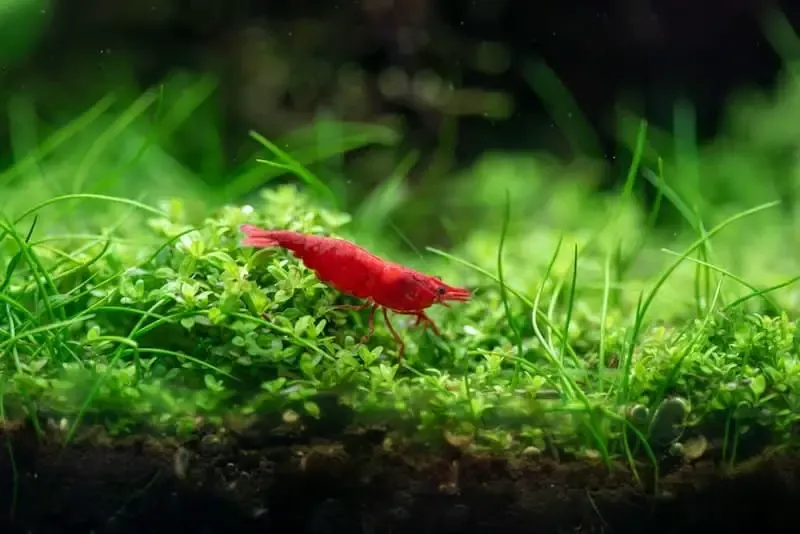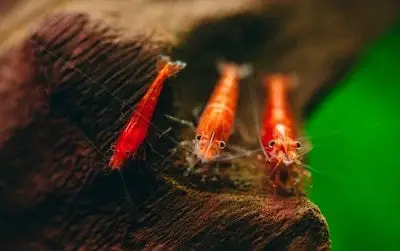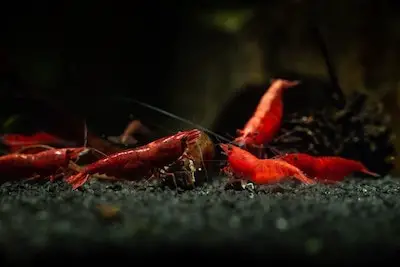Dead Cherry Shrimp: How to Prevent It!
Red cherry shrimp are a popular and attractive strain of the Neocaridina genus, but their molting behavior sometimes puzzles both novice and seasoned shrimp keepers.
Dead cherry shrimp sometimes resemble molting shrimp, so it can be challenging to tell the difference.
Fortunately, there are ways to keep the colony healthy and prolong the lifespan of your cherry shrimp. Maintaining appropriate water conditions and optimal temperature levels, a balanced diet, and acclimatization help prevent cherry shrimp death.
This article will discuss the best tips for keeping your cherry shrimp alive and help you distinguish between shrimp death and molting.
Keep reading to learn more.

Contents
How Do You Know If Cherry Shrimp Are Dead (Are They Dead or Molting)?
Noticing a shrimp has died can be challenging since the other shrimp may feed on the carcass. Also, molting shrimp often remain out of view and hide underneath tank plants.
However, the main difference between dead and molting shrimp is their color.
For example, dead red cherry shrimp lose their signature reddish pigmentation and attain a pink hue, while a shell resembles a live shrimp.
Another difference is the “white ring of death.” This phenomenon affects most shrimp species when they’re molting.
Whereas dead shrimp show no anomalies on their bodies, shrimp shedding sometimes develop a white line across the exoskeleton.
The line or split appears between the body and the head, and it’s supposed to help the shrimp escape its shell.
If the exoskeleton splits at the top, the shrimp will survive the molting process. But when the split envelops the entire body, the shrimp is trapped in the exoskeleton, unable to wriggle out.
Shrimp with the “white ring of death” sometimes lie motionless, so you might assume they’ve died.
However, you can examine their bodies closely to see whether there’s a white split. If that’s the case, the shrimp will struggle to break free from their shell.
Although most shrimp don’t survive the breaking of the exoskeleton, some shrimp keepers help them escape by holding part of the shell open with tweezers.
This is potentially dangerous since shrimp are delicate creatures and should be handled with care.
Why Do My Cherry Shrimp Keep Dying?
The red cherry shrimp is one of the most attractive Neocardinia davidi species, and it requires regular upkeep to survive and thrive in freshwater tanks.
Several factors may result in dead cherry shrimp cluttering the tank (they reproduce fairly quickly), including old age, excess chemicals, unsuitable store conditions, inadequate acclimatization, and inappropriate tank conditions.
If you spot a dead shrimp, there may be no underlying issue. Red cherry shrimp typically survive for two years in perfect water conditions.
While old age can account for one or two dead shrimp, other aspects may cause recurring shrimp death in your tank.
Some retail stores that sell shrimp fail to properly take care of the creatures and degrade their health. By the time you introduce them to your tank, they’ve experienced extreme stress and cannot recover.
While a balanced diet and optimal water conditions help nurse some shrimp back to health, many could die due to the maltreatment in the store.
Red cherry shrimp become overwhelmed when they’re transported to new tanks.
Unless you acclimate them before placing them in the tank, their body will be unable to cope with the shock, leading to shrimp death.
Tank conditions such as cycling, pH levels, temperature spikes, and excess chemicals also affect the lifespan of red cherry shrimp.
When placed in uncycled tanks, the creatures are exposed to high concentrations of nitrites and ammonia, which minimize their survival rate.
Water hardness, pH imbalances, and temperature fluctuations make the shrimp more vulnerable, so regularly check the tank conditions to ensure you’re maintaining a healthy environment.
If you’ve been treating sick shrimp with medicine, consult a professional.
Some medicines contain harmful chemicals that may endanger your shrimp colony. Also, steer clear of medication that contains copper since this is a highly toxic element.
Moreover, be careful about decorating your tank with plants. Shrimp enjoy green tanks, but some plants may act as a source of toxic elements like lead or copper.
Do I Need to Remove Dead Cherry Shrimp From My Tank?
It’s best to remove a dead cherry shrimp as soon as you spot it. If the carcass sits in the tank for too long, the decomposition process could infect the water and put the colony at risk.
Another reason why you should remove dead shrimp immediately is disease prevention.
For example, if the dead shrimp suffered from parasites, the water may carry the parasites and infect the remaining shrimp.
Warm water quickens the decomposition process, and the ammonia levels rise. This toxic substance degrades the colony’s immune system, causing long-term health problems.
Additionally, ammonia spikes negatively affect the appetite of the shrimp and hatching rates.
Tips for Keeping Cherry Shrimp Alive
Red cherry shrimp live long and healthy lives in freshwater tanks with regular upkeep.
To help your colony thrive, monitor and adjust the water conditions regularly, eliminate toxins, provide the shrimp with a nutritious diet, and minimize shock.
Let’s get into three key habits you should maintain.
Test The Tank Water Regularly
Tank water should be tested once a week.
For red cherry shrimp, pH levels should be between 6.2 and 8, while ammonia and nitrite concentration should be at 00ppm. Nitrate levels shouldn’t exceed 20ppm.
If these parameters are out of balance, it’s best to replace the tank water. Keep in mind that you should gradually change the water to minimize shock and prevent premature shrimp death.
Optimal parameters also prevent complications like “the white ring of death” and the development of pathogens.
Clean Plants Before Adding Them to Your Tank
When adding new plants to the tank, go for species that haven’t been doused in pesticides.
Before submerging the plants into the tank water, give them a thorough wash in the sink.
Don’t Overfeed
Avoid overfeeding the shrimp. They eat organic matter like plants, so giving them small portions once a day will keep them healthy.
Overfeeding the shrimp leads to increased waste production, which affects the water’s pH and chemical levels.
In Summary
Red cherry shrimp elevate the appearance of any freshwater tank, and regular maintenance keeps them in perfect condition.
However, dead cherry shrimp in the tank may indicate underlying issues with the water conditions.
Fortunately, you can quickly create a safe and healthy environment for your colony.
To help your shrimp stay alive and healthy, maintain optimal pH and chemical levels, and provide them with a balanced diet.
Also, before housing them in the tank, don’t forget to acclimate new batches to lower stress levels and minimize shock.


